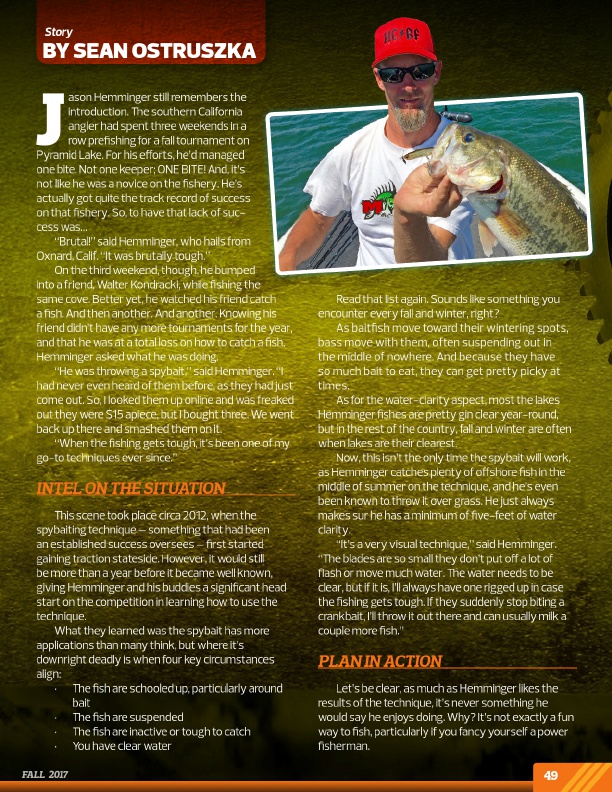
FALL 2017
Story
BY SEAN OSTRUSZKA
J
ason Hemminger still remembers the
introduction. The southern California
angler had spent three weekends in a
row prefishing for a fall tournament on Pyramid Lake. For his efforts, he’d managed
one bite. Not one keeper; ONE BITE! And, it’s
not like he was a novice on the fishery. He’s
actually got quite the track record of success
on that fishery. So, to have that lack of suc-
cess was…
“Brutal!” said Hemminger, who hails from
Oxnard, Calif. “It was brutally tough.”
On the third weekend, though, he bumped
into a friend, Walter Kondracki, while fishing the
same cove. Better yet, he watched his friend catch
a fish. And then another. And another. Knowing his
friend didn’t have any more tournaments for the year,
and that he was at a total loss on how to catch a fish,
Hemminger asked what he was doing.
“He was throwing a spybait,” said Hemminger. “I
had never even heard of them before, as they had just
come out. So, I looked them up online and was freaked
out they were $15 apiece, but I bought three. We went
back up there and smashed them on it.
“When the fishing gets tough, it’s been one of my
go-to techniques ever since.”
INTEL ON THE SITUATION
This scene took place circa 2012, when the spybaiting technique – something that had been an established success oversees – first started gaining traction stateside. However, it would still be more than a year before it became well known, giving Hemminger and his buddies a significant head start on the competition in learning how to use the technique.
What they learned was the spybait has more applications than many think, but where it’s downright deadly is when four key circumstances align:
• The fish are schooled up, particularly around
bait
• The fish are suspended
• The fish are inactive or tough to catch
• You have clear water
Read that list again. Sounds like something you encounter every fall and winter, right?
As baitfish move toward their wintering spots, bass move with them, often suspending out in the middle of nowhere. And because they have so much bait to eat, they can get pretty picky at times.
As for the water-clarity aspect, most the lakes Hemminger fishes are pretty gin clear year-round, but in the rest of the country, fall and winter are often when lakes are their clearest.
Now, this isn’t the only time the spybait will work, as Hemminger catches plenty of offshore fish in the middle of summer on the technique, and he’s even been known to throw it over grass. He just always makes sur he has a minimum of five-feet of water clarity.
“It’s a very visual technique,” said Hemminger. “The blades are so small they don’t put off a lot of flash or move much water. The water needs to be clear, but if it is, I’ll always have one rigged up in case the fishing gets tough. If they suddenly stop biting a crankbait, I’ll throw it out there and can usually milk a couple more fish.”
PLAN IN ACTION
Let’s be clear, as much as Hemminger likes the results of the technique, it’s never something he would say he enjoys doing. Why? It’s not exactly a fun way to fish, particularly if you fancy yourself a power fisherman.
49